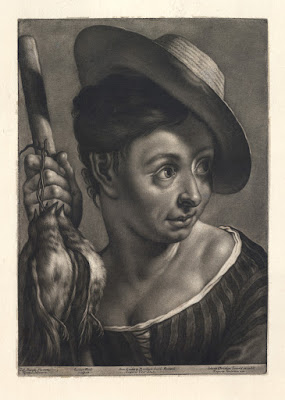Johann
Lorenz Haid (1702–1750)
“Girl holding a brace of field larks” (descriptive title only), c.1750,
after Giovanni Battista Piazzetta (1682–1754),
published with privilege (inscribed on plate as “Sacri Romani Imperii
Vicaratius”) by Johann Christian Leopold (1699–1755) in Augsburg.
Mezzotint on laid paper, trimmed along the platemark and backed
with a support sheet.
Size: (sheet) 38.6 x 27.5 cm; (image borderline) 37.5 x 27.1 cm
Inscribed on plate below the image borderline: (left) “Ioh.
Baptista Piazzetta / Venetus delineavit”; (left of centre) “Lorenz Haid / sculpsit”;
(centre) “Cum Gratia et Privilegio Sacri Romani / Imperii Vicariatus.”; (right)
“Iohann Christian Leopold excudit / Augustae Vindelicorum”
Condition: richly inked and well-printed impression with many
(almost invisible) restorations, trimmed along the platemark and backed with a
support sheet of archival (millennium quality) washi paper.
I am selling this spectacular mezzotint (with MANY almost
invisible restorations) for the total cost of AU$216 (currently US$163.80/EUR135.02/GBP118.89
at the time of posting this print) including postage and handling to anywhere in the
world.
If you are interested in purchasing this rare—so rare that the
neither the British Museum nor the Rijksmuseum hold a copy—large and luminously
glowing old-master print, please contact me (oz_jim@printsandprinciples.com)
and I will send you a PayPal invoice to make the payment easy.
This print has been sold
Only when the long and labour intensive process of making a
mezzotint is understood (see https://en.wikipedia.org/wiki/Mezzotint)
can the skill and discipline required to execute this tour de force masterwork
be fully appreciated. Interestingly, Haid’s teacher was the great mezzotinter, Johann
Christian Rugendas (1708–1781), and the leaning of Rugendas towards theatrical
lighting (see my earlier post showcasing Rugendas’ prints: http://www.printsandprinciples.com/2017/02/johann-christian-rugendas-mezzotint.html)
seems to have been adopted by his pupil. There is a significant difference, nevertheless,
in both artists’ approaches to mezzotint. Rugendas tends to outline his
subjects whereas Haid relies on careful tonal phrasing to define his forms. For
example, note how Haid has very subtly suggested reflected light in the shadow cast
by girl’s hat on her forehead. By contrast, Rugendas uses tone in flat patterns
that the eye reads as spatial planes.
Regarding the subject of this print, I believe that the portrayed
young girl’s name may be “Rosa.” My attribution of this name for the girl is based
on a chalk drawing by Giovanni Battista Piazzetta—upon whom this print is after—of
a girl with similar facial features and dressed in almost the same clothes; see
“A Portrait of Rosa with a Shoulder Stick”, c. 1735, in the collection of the
Cleveland Museum of Art: http://www.clevelandart.org/art/1931.59?f%5B0%5D=field_artist:Giovanni%20Battista%20Piazzetta%20(Italian,%201682-1754)








No comments:
Post a Comment
Please let me know your thoughts, advice about inaccuracies (including typos) and additional information that you would like to add to any post.